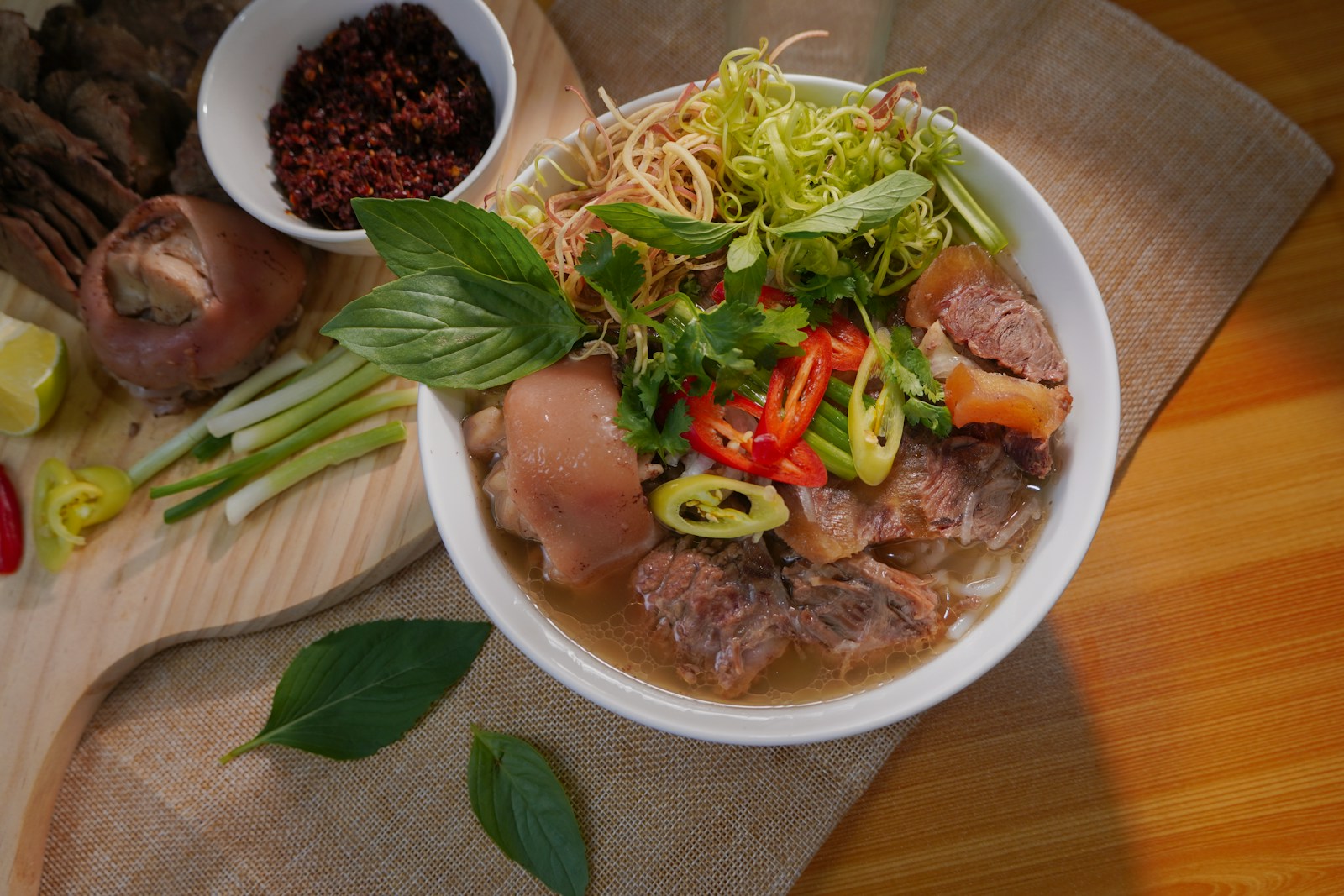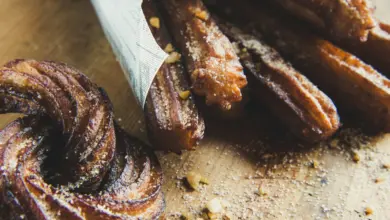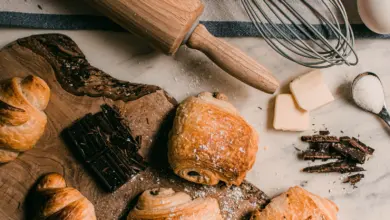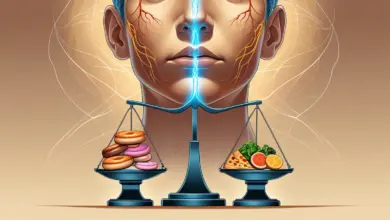Bun Bo Hue, a flavorful Vietnamese noodle soup, is loved for its spicy kick and hearty ingredients. But if you’re living with type 1 diabetes, you may wonder if it can fit into your diet. The good news? With mindful carb counting and portion control, Bun Bo Hue can be enjoyed without compromising your blood sugar management. This post will guide you on how to savor this dish responsibly, ensuring both taste and health are balanced.
For related insights on managing diabetes, check out Does Diabetes Cause Hair Loss: What You Need to Know.
Understanding Type 1 Diabetes
Type 1 diabetes is a lifelong condition, but understanding it can empower those living with it to make informed choices. This section breaks down the basics of this autoimmune disorder and how it influences dietary decisions.
Overview of Type 1 Diabetes
Type 1 diabetes is an autoimmune condition where the body’s immune system mistakenly attacks insulin-producing beta cells in the pancreas. Without sufficient insulin, glucose stays in the bloodstream, leading to high blood sugar levels. Insulin is essential because it helps convert sugar from food into energy for daily activities.
Since this condition cannot be prevented or cured, management is key. People with type 1 diabetes typically require daily insulin therapy, frequent blood sugar monitoring, and a balanced lifestyle. Regular checkups and education are crucial for staying ahead of complications. For further insights into diabetes-related challenges, check out How Is Diabetes Secondary to PTSD | Health Guide.
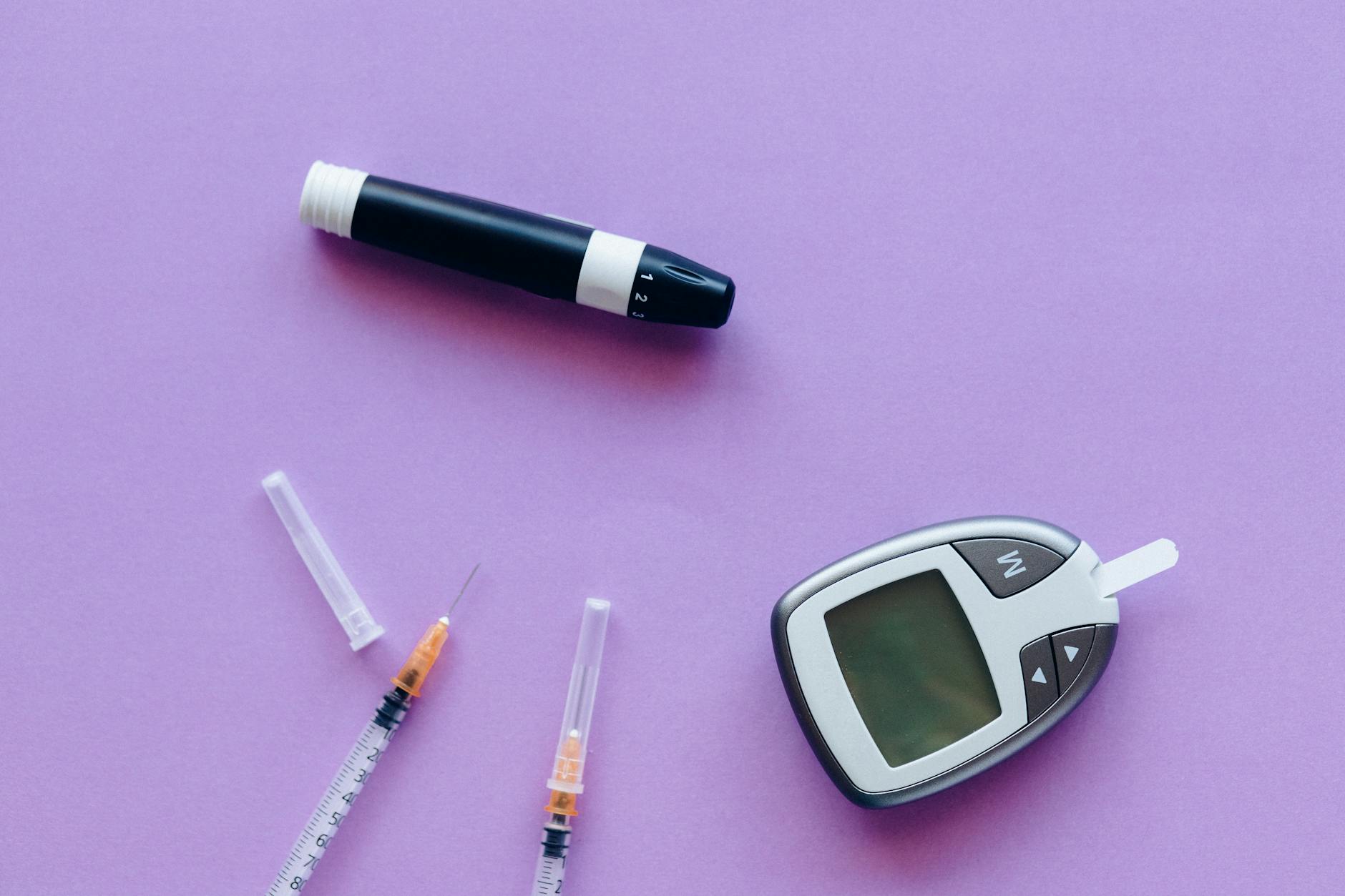
Photo by Nataliya Vaitkevich
For a deeper understanding, explore the American Diabetes Association’s resource on type 1 diabetes. It provides comprehensive guidance on causes, symptoms, and treatments.
Impact on Dietary Choices
What you eat significantly affects blood sugar levels when managing type 1 diabetes. Foods high in carbohydrates cause glucose to spike, as they’re broken down into sugar during digestion. Therefore, people with type 1 diabetes need to monitor and adjust their carbohydrate intake carefully.
Here are a few dietary considerations:
- Carb Counting: Accurately count carbs to determine how much insulin you may need. Tools like apps and calculators help simplify this process.
- Glycemic Index (GI): Focus on foods with a low GI score. These cause slower, steadier increases in blood sugar.
- Balanced Meals: Combine carbs with protein and healthy fats to stabilize glucose levels.
When it comes to enjoying favorite dishes—like Bun Bo Hue—understanding portion sizes, ingredient adjustments, and timing your insulin are important for avoiding blood sugar rollercoasters. For more detailed guidance, you can check out the CDC’s information on type 1 diabetes.
By mastering dietary management, you can enjoy a variety of foods while maintaining stable glucose levels. Remember, knowledge is power when balancing health and cravings!
Key Takeaways
Understanding the relationship between foods like Bun Bo Hue and type 1 diabetes is essential for managing blood sugar effectively. Let’s dive into the critical aspects you need to know when choosing to enjoy this flavorful dish.
Monitoring Carb Content and Portion Sizes
Bun Bo Hue typically contains rice noodles, beef or pork, vegetables, and herbs, all submerged in a robust, slightly spicy broth. Rice noodles are the primary carbohydrate source in this dish.
- Carb Count: A standard bowl of Bun Bo Hue may contain approximately 40-50 grams of carbohydrates per serving. This makes it essential to adjust your insulin dose accordingly.
- Smaller Portions: Splitting your meal into two smaller portions or sharing is a great way to reduce your carb intake while still enjoying the flavor.
If you’re uncertain about exact carb counts, tools like the Carb Manager app can help estimate nutritional values of specific Vietnamese dishes.
Role of Protein
Protein plays a vital role in creating balanced meals for people with type 1 diabetes. Fortunately, Bun Bo Hue is rich in proteins through its beef brisket or pork hock components.
- Why It Matters: Protein slows down the digestion of carbohydrates, helping to maintain steady blood sugar levels after a meal.
- Pro Tip: Pairing Bun Bo Hue with extra lean meats or tofu can further boost the protein content without adding unnecessary calories or fats.
Managing Spices and Sodium
The spicy broth of Bun Bo Hue is accented with lemongrass, chili, and shrimp paste. While the spices can be diabetic-friendly, the shrimp paste and broth base are often high in sodium.
- Excess Sodium: High amounts of salt in the diet can lead to elevated blood pressure, which diabetic individuals are more prone to.
- Adjustment Options: Ask for less salt in the broth or dilute it with water if it feels too salty. Also, monitor your blood pressure regularly if you consume salty foods frequently.
Timing Insulin and Pre-Bolusing
Enjoying Bun Bo Hue safely often depends on the timing of your insulin dose.
- Pre-Bolus Timing: Pre-bolusing 15-20 minutes before eating can help mitigate post-meal blood sugar spikes, especially for carb-heavy dishes.
- Continuous Monitoring: Keep your glucometer or CGM device handy while experimenting with meals to see how your body reacts.
Curious about foods that complement Vietnamese flavors without spiking glucose? Explore Can Another Type of Noodle Be Eaten While Diabetic?.
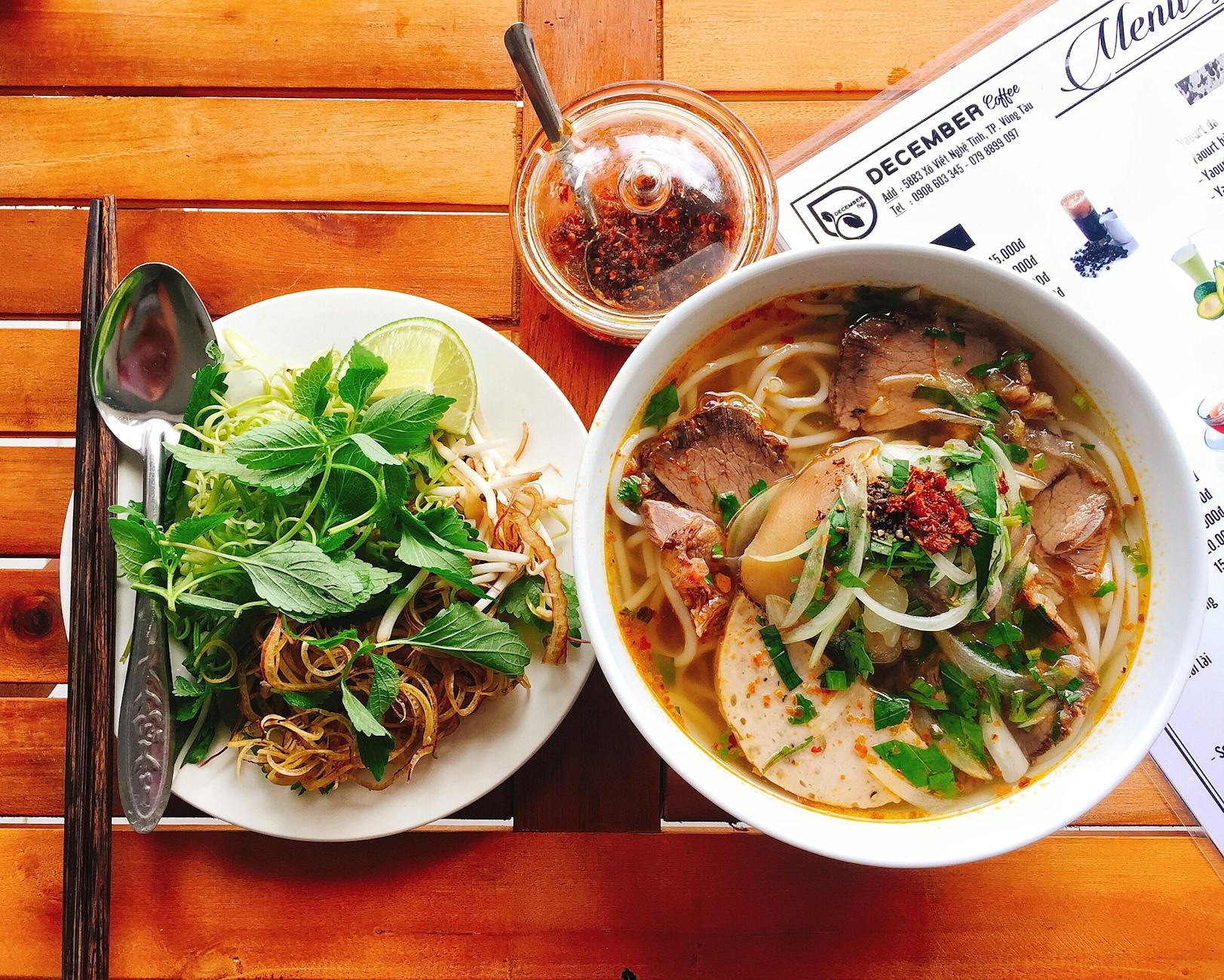
Photo by JANG ‘S 🍂
By monitoring your portion sizes and understanding adjustments like pre-bolusing or adding proteins, you can confidently manage blood sugar levels while savoring a delicious bowl of Bun Bo Hue.
Nutritional Profile of Bun Bo Hue
Bun Bo Hue is a beloved Vietnamese noodle soup with a vibrant mix of complex flavors. It’s known for its spicy broth and hearty ingredients, making it a comfort food staple that satisfies the palate. But what exactly goes into this dish, and how do its components break down nutritionally? Let’s take a closer look.
Ingredients in Bun Bo Hue
Bun Bo Hue is celebrated for its rich, aromatic composition. Below are the typical ingredients that make up this flavorful dish:
- Rice Noodles: The primary carbohydrate source, offering a chewy texture that absorbs the spicy broth.
- Beef and Pork: Common proteins include beef shank, pork hock, and sometimes Vietnamese sausage (cha lua).
- Broth: The heart of the dish, made with beef bones, lemongrass, shrimp paste, chili oil, and fish sauce.
- Herbs and Greens: Fresh herbs like cilantro, sliced onions, banana blossoms, and bean sprouts add aroma and crunch.
- Other Additions: Pig’s blood cubes and lime wedges are often available for those who prefer a traditional approach.
Each ingredient contributes unique flavors and nutritional components to Bun Bo Hue, making it a nutrient-rich meal when enjoyed in moderation.

Photo by Angela Roma
Nutritional Content Analysis
Bun Bo Hue offers a balanced mix of macronutrients. However, its exact nutritional content can differ depending on the recipe and serving size. Here’s a closer look at the typical breakdown:
Carbohydrates
Rice noodles are the primary source of carbohydrates in this dish. A typical bowl contains around 40-60 grams of carbs, depending on the portion size. This makes carb counting essential for individuals managing type 1 diabetes. For specific carb estimates, tools like Carb Manager can help you better understand how this dish fits into your daily intake.
Protein
The beef and pork components, along with the broth enriched with bone marrow, contribute 13-36 grams of protein per serving. Proteins help slow down the digestion of carbohydrates, which can be beneficial for keeping blood sugar levels stable.
Fat
The broth and proteins also include fats. A single serving contains an average of 15-20 grams of fat, varying with preparation methods. While the fat helps enhance the dish’s rich flavor, it’s worth noting that saturated fat may raise cholesterol levels with excessive consumption.
Micronutrients
Thanks to the fresh herbs, lime, and greens, Bun Bo Hue delivers valuable vitamins such as Vitamin C and minerals like iron. However, the shrimp paste and fish sauce can add a significantly high amount of sodium, so consider moderation or diluted preparation to lower the salt content.
For a full overview of Bun Bo Hue’s calories and macronutrients, consider visiting Calories in Bun Bo Hue – Nutritionix.
By understanding what goes into Bun Bo Hue and its nutritional composition, you can make informed choices about how to enjoy this traditional dish without compromising on dietary goals.
Managing Carbohydrates with Type 1 Diabetes
Managing carbohydrates is a cornerstone of living well with type 1 diabetes. Carbs directly impact blood sugar levels and require proper planning and insulin adjustments. Let’s explore two key aspects: understanding carbohydrate counting and pre-meal insulin management.
Understanding Carbohydrate Counting
Carbohydrate counting, or “carb counting,” helps you measure the grams of carbohydrates in your meals. Since carbs influence blood sugar levels the most, this method is the foundation of diabetes management.
Why is it important for someone with type 1 diabetes? Insulin doses are matched to the amount of carbs consumed. Eating without counting carbs is like trying to drive without a speedometer—it’s hard to estimate your direction. By accurately counting carbs, you can:
- Prevent Blood Sugar Spikes: Adjust insulin to keep glucose levels stable.
- Stay Flexible: Enjoy a variety of foods, including dishes like Bun Bo Hue.
- Achieve Personalized Goals: Customize your diet to energy needs and lifestyle.
For tools and resources to make carb counting easier, check out Carb Counter and Diabetes from the American Diabetes Association. They offer tips and a simple guide for estimating carbs in meals.
If you’re unsure about portion sizes or carb counts for certain foods like noodles, apps like MyFitnessPal or dietitian advice can help fine-tune your understanding.

Photo by Pavel Danilyuk
Pre-Meal Insulin Management
Adjusting insulin before meals is essential when managing type 1 diabetes. Proper pre-meal insulin dosing ensures a steadier blood sugar response, especially after eating carbohydrate-rich dishes.
Here’s how to manage it effectively:
- Calculate Total Carbohydrates: Use carb counting to estimate grams in your meal. For example, a bowl of Bun Bo Hue might have 40-50 grams of carbs due to its rice noodles.
- Use an Insulin-to-Carb Ratio: This is the amount of insulin needed for every gram of carbs. For instance, if your ratio is 1 unit per 10 grams of carbs, you’d need 4-5 units for Bun Bo Hue.
- Timing is Key: Inject insulin 15-20 minutes before eating, especially for high-carb meals. This helps prevent post-meal blood sugar spikes.
- Monitor and Adjust: Use your glucose monitor to track post-meal levels. Over time, you’ll learn how your body reacts to specific foods.
Complex meals, like Bun Bo Hue, may also include fats and proteins that slow carb absorption. It’s important to keep this in mind when timing your insulin. For deeper insights, explore this guide on Counting Carbohydrates.
By combining accurate carb counting with pre-meal insulin adjustments, you can enjoy a variety of meals confidently, managing your blood sugar effectively. For more tips on carbohydrates and blood sugar control, visit Are Grits Good for Diabetics?.
Can I Eat Bun Bo Hue with Type 1 Diabetes?
Bun Bo Hue, a spicy Vietnamese noodle soup, can still be enjoyed even if you’re managing type 1 diabetes. However, it’s key to make thoughtful adjustments that fit your dietary and insulin needs. With its rich flavors and hearty ingredients, making Bun Bo Hue diabetes-friendly is not as challenging as it might seem.
Portion Control and Moderation
One of the most important considerations for eating Bun Bo Hue when managing type 1 diabetes is portion size. Why? Because the rice noodles in this dish are a primary carbohydrate source, and carbs can quickly raise blood sugar levels.
- A standard serving of Bun Bo Hue contains approximately 40-50 grams of carbohydrates due to the rice noodles.
- Keep portions smaller to help stabilize your glucose levels. Consider enjoying half a bowl or sharing your meal with someone.
- Pair your meal with a side of non-starchy vegetables or a protein-rich snack to help balance your blood sugar.
Remember, track your carbs and adjust your insulin dosage accordingly. Need a detailed carb analysis for Bun Bo Hue? Check out Carbs in Pho Cafe Bun Bo Hue. Tools like Carb Manager make estimating easier!
Making Healthier Choices
If you’re looking to still enjoy Bun Bo Hue while managing type 1 diabetes, small adjustments to the recipe can make a big difference. Here’s how:
- Swap Rice Noodles: Substitute traditional rice noodles with a low-carb option like zucchini noodles or shirataki noodles. These alternatives have fewer carbs and don’t spike glucose as quickly.
- Control Sodium: The broth often contains shrimp paste and fish sauce, which are high in sodium. High sodium intake can increase blood pressure, which is a concern for diabetics. Ask for less salt or dilute the broth with water.
- Boost Your Protein: Add more meat or tofu to help offset the carbs and stabilize blood sugar. Protein slows the digestion of carbohydrates, making it easier to maintain steady glucose levels.
- Limit Garnishes: Lime juice, fresh herbs, and beansprouts are generally fine. However, skip extras like fried shallots or fatty pork toppings that may add unnecessary calories and fats.
Making simple swaps doesn’t mean missing out on flavor. For more ideas on diabetic-friendly meals, read Can Another Type of Noodle Be Eaten While Diabetic?.
By embracing portion control and exploring healthier ingredient options, Bun Bo Hue can remain a joyful part of your diet without wavering on blood sugar stability.
Citations and Trusted Resources
When managing type 1 diabetes, relying on credible sources for guidance is vital. Accurate information helps you make informed decisions about your health while avoiding myths and misconceptions. Let’s break down why citations matter and how to find trustworthy resources.
Why Citations Matter
Citations serve as the backbone of reliable information. In the context of managing diabetes, what you read can directly impact your health choices. Well-cited information ensures accuracy and compliance with the latest medical standards. Imagine trying to solve a puzzle; credible sources are like the corner pieces that set the foundation.
For instance:
- Medical Research: Peer-reviewed studies enhance credibility.
- Guidelines from Health Authorities: Trusted bodies like the American Heart Association provide verified data and tools for diabetes care.
- Evidence-Based Resources: Check out platforms like Healthy People 2030 for proven strategies in disease prevention and management.
Citations also allow you to verify claims, ensuring the advice is credible and up-to-date. Whether you’re understanding the carb content of Bun Bo Hue or exploring insulin management tips, citations bridge the gap between anecdotal advice and scientifically-backed strategies.
Recognizing Trusted Sources
In a world where online misinformation is rampant, knowing where to look for reputable diabetes resources is key. Trusted sources share a few common characteristics:
- Affiliation with Reputable Institutions
Health topics like diabetes management are often best explained by renowned organizations. Start with resources like the National Institute of Diabetes and Digestive and Kidney Diseases (NIDDK) or the American Diabetes Association. - Evidence-Based Information
Look for content backed by studies, like articles from PubMed or journals. For example, community-based innovations in diabetes care are explored in studies like this insightful research article. - Practical Tools and Support
Trusted sources often provide actionable tools, whether it’s a food-tracking app or glucose-monitoring tips. The ADA offers tools and resources designed for everyday use. - Clear Author Credentials
Choose advice authored by qualified professionals—endocrinologists, nutritionists, or certified diabetes educators. - Updated Content
Diabetes research evolves. Always check for recently updated articles or policies that reflect the latest advancements in care.
By recognizing these traits, you’ll navigate through resources with confidence, knowing the guidance aligns with established science and medical recommendations.
How to Use Resources Effectively
Having access to trusted resources is one thing—but how can you integrate them into your daily life? Here’s a quick guide:
- Meal Planning: Use tools like a carb calculator or glycemic index chart to plan manageable meals, such as Bun Bo Hue.
- Insulin Adjustments: Interactive resources, like those provided by the American Heart Association, guide you in timing your insulin doses effectively.
- Community Support: Join diabetes-focused forums or support groups to share experiences and learn from others.
- Emergency Preparedness: Resources from trusted organizations prepare you for unexpected situations, like hypoglycemia or illness.
Finally, always cross-check information with your healthcare provider. While online resources provide a great start, professional medical advice should be your ultimate guide.

Photo by Pavel Danilyuk
For additional help, explore the Diabetes section on Health100 to better understand nutritional strategies and management for diabetics. Reliable information empowers you to maintain a balanced, diabetes-friendly lifestyle while still enjoying your favorite meals, like Bun Bo Hue.
Conclusion
Bun Bo Hue is a flavorful dish that can fit into a diabetes-friendly meal plan with the right strategies. By managing portions, balancing protein, and monitoring carbohydrate intake, you can enjoy this Vietnamese favorite without disrupting blood sugar stability.
Your journey with type 1 diabetes doesn’t mean giving up favorite foods—it means making informed adjustments. Remember to count carbohydrates, time your insulin, and explore healthier ingredient swaps. This balance allows you to savor what you love while prioritizing your health.
For more diabetes-friendly eating tips, check out Is Popcorn Bad for Diabetics? Blood Sugar Guide.

